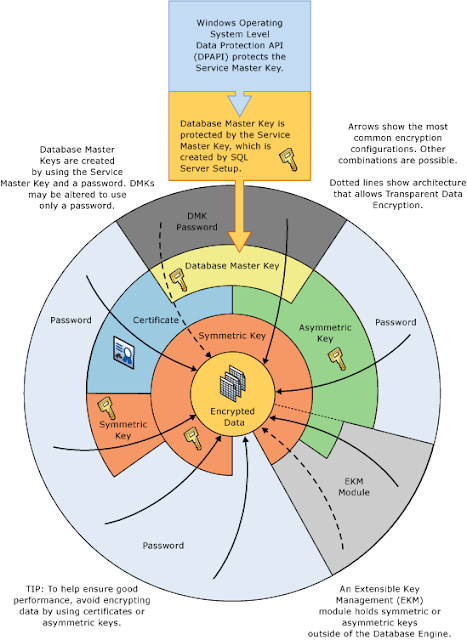In this post we will look at a complete end to end routine for encrypting, storing, decrypting data in SQL Server and just how easy it is to set-up and maintain. SQL Server encrypts data with a hierarchical encryption and key management infrastructure. Each layer encrypts the layer below it by using a combination of certificates, asymmetric keys, and symmetric keys. It is important to understand the different layers of protection, how they interact the performance overhead and best practices. Books Online has a great visualisation of the SQL Server encryption hierarchy which I have included below.
Script
Below is the script used to create both the encryption / decryption routine and the equivalent routine without encryption. You will need to Modify the below;
-- Change the database name below
-- Change the path to the database master key backup OPEN MASTER KEY DECRYPTION BY PASSWORD = 'rZVb3DwZ8Vptc2#vm4wapspB'; BACKUP MASTER KEY TO FILE = 'C:\SQL\Backup\DatabaseMasterKeys\SQLServer365DatabaseMasterKey' ENCRYPTION BY PASSWORD = 'ratr7XgGGSJ5dM4QzAaXc8cj';
-- Change the path to the certificate backup BACKUP CERTIFICATE CertBankDetails TOFILE = 'C:\SQL\Backup\Certificates\CertBankDetails';
----------------------------------------------------------------- Encryption / Decryption Routine ----------------------------------------------------------------- For more SQL resources, check out SQLServer365.blogspot.com ----------------------------------------------------------------- You may alter this code for your own purposes. You may republish altered code as long as you give due credit. You must obtain prior permission before blogging this code. THIS CODE AND INFORMATION ARE PROVIDED "AS IS" ----------------------------------------------------------------- WHERE [object_id] =OBJECT_ID('dbo.BankDetails') CREATE TABLE dbo.BankDetails( BankDetailsID INT IDENTITY(1,1) NOT NULL CONSTRAINT [PK_BankDetails:BankDetailsID] PRIMARY KEY, SortCode VARBINARY(128) NOT NULL, AccountNumber VARBINARY(128) NOT NULL, InsertDate DATETIME NOT NULL CONSTRAINT [DF_BankDetails:InsertDate] DEFAULT (GETDATE()) PRINT 'Error: Table "dbo.BankDetails" already exists, please modify the script to create a table name that does not already exist'; -- Create database master key This is the database master key that is used to encrypt all certificates when a password is not supplied WHERE name = '##MS_DatabaseMasterKey##') CREATE MASTER KEY ENCRYPTION BY PASSWORD = 'rZVb3DwZ8Vptc2#vm4wapspB' PRINT 'Error: Database master key already exists!' OPEN MASTER KEY DECRYPTION BY PASSWORD = 'rZVb3DwZ8Vptc2#vm4wapspB'; BACKUP MASTER KEY TO FILE = 'C:\SQL\Backup\DatabaseMasterKeys\SQLServer365DatabaseMasterKey' ENCRYPTION BY PASSWORD = 'ratr7XgGGSJ5dM4QzAaXc8cj'; This is the certificate used to protect the symmetric key WHERE name = 'CertBankDetails' ) CREATE CERTIFICATE CertBankDetails WITH SUBJECT = 'Bank Details Certificate', EXPIRY_DATE = '02/25/2014'; PRINT 'Error: Certificate "CertBankDetails" already exists, please modify the script to create a certificate that does not already exist'; -- Backup the certificate BACKUP CERTIFICATE CertBankDetails TOFILE = 'C:\SQL\Backup\Certificates\CertBankDetails'; This is the symmetric key used in conjunction with the certificate to encrypt / decrypt the data WHERE name = 'SymKeyBankDetails' ) CREATE SYMMETRIC KEYSymKeyBankDetails ENCRYPTION BY CERTIFICATECertBankDetails; PRINT 'Error: Symmetric key "SymKeyBankDetails" already exists, please modify the script to create a symmetric key that does not already exist'; -- Create Encryption Proc WHERE [object_id] =OBJECT_ID('dbo.spInsertBankDetails') DROP PROCEDURE dbo.spInsertBankDetails CREATE PROCEDURE dbo.spInsertBankDetails OPEN SYMMETRIC KEYSymKeyBankDetails DECRYPTION BY CERTIFICATECertBankDetails; INSERT INTO SQLServer365.dbo.BankDetails EncryptByKey(Key_GUID('SymKeyBankDetails'), '01-02-03'), -- Encrypt SortCode EncryptByKey(Key_GUID('SymKeyBankDetails'), '01234567'), -- Encrypt AccountNumber -- Create Decryption Proc WHERE [object_id] =OBJECT_ID('dbo.spGetBankDetails') DROP PROCEDURE dbo.spGetBankDetails CREATE PROCEDURE dbo.spGetBankDetails OPEN SYMMETRIC KEYSymKeyBankDetails DECRYPTION BY CERTIFICATECertBankDetails; -- Return decrypted record CONVERT(VARCHAR, DecryptByKey(SortCode)) AS SortCode, -- Decrypt SortCode CONVERT(VARCHAR, DecryptByKey(AccountNumber)) AS AccountNumber, -- Decrypt AccountNumber FROMSQLServer365.dbo.BankDetails; -- Insert an encrypted record EXECSQLServer365.dbo.spInsertBankDetails; FROMSQLServer365.dbo.BankDetails; EXECSQLServer365.dbo.spGetBankDetails; Unencrypted data for performance comparison WHERE [object_id] =OBJECT_ID('dbo.BankDetailsNoEncryption') CREATE TABLE dbo.BankDetailsNoEncryption( BankDetailsNoEncryptionID INT IDENTITY(1,1) NOT NULL CONSTRAINT[PK_BankDetailsNoEncryption:BankDetailsNoEncryptionID] PRIMARYKEY, SortCode VARCHAR(50) NOT NULL, AccountNumber VARCHAR(50) NOT NULL, InsertDate DATETIME NOT NULL CONSTRAINT [DF_BankDetailsNoEncryption:InsertDate] DEFAULT (GETDATE()) PRINT 'Error: Table "dbo.BankDetailsNoEncryption" already exists, please modify the script to create a table name that does not already exist'; WHERE [object_id] =OBJECT_ID('dbo.spInsertBankDetailsNoEncryption') DROP PROCEDURE dbo.spInsertBankDetailsNoEncryption CREATE PROCEDURE dbo.spInsertBankDetailsNoEncryption INSERT INTO SQLServer365.dbo.BankDetailsNoEncryption WHERE [object_id] =OBJECT_ID('dbo.spGetBankDetailsNoEncryption') DROP PROCEDURE dbo.spGetBankDetailsNoEncryption CREATE PROCEDURE dbo.spGetBankDetailsNoEncryption SELECT BankDetailsNoEncryptionID , FROM SQLServer365.dbo.BankDetailsNoEncryption; -- Insert unencrypted record EXECSQLServer365.dbo.spInsertBankDetailsNoEncryption; EXECSQLServer365.dbo.spGetBankDetailsNoEncryption; GO
Performance Comparison
I did some performance analysis comparing the insert encrypting the data / the select decrypting the data to the equivalent without encryption and decryption. I used SQLQueryStress by Adam Machanic to execute the insert and select of both routines 100 times across 10 threads, the results of which I have to say might surprise a few of you;
| | | |
| | | |
Client Seconds / Iteration (Avg) | | | |
Logical Reads / Iteration (Avg) | | | |
CPU Seconds / Iteration (Avg) | | | |
Actual Seconds / Iteration (Avg) | | | |
| | | |
| | | |
| | | |
Client Seconds / Iteration (Avg) | | | |
Logical Reads / Iteration (Avg) | | | |
CPU Seconds / Iteration (Avg) | | | |
Actual Seconds / Iteration (Avg) | | | |
With this significant overhead, I recommend you make sure you have the capacity to make use of SQL Servers encryption hierarchy. It is important to be selective, only encrypt data that you actually need to. Investigate the use of an Hardware Security Module (HSM) as these add a layer of abstraction by keeping the encryption keys separate from the the encrypted data. It is also possible to offload the encryption overhead from the SQL Server to the HSM for improved performance.
I will finish with 3 recommendations;
Backup the certificates and keys!
Simple really, make sure you backup all your database master keys and all your certificates, the usual precautions apply here as they do for all backups;
- Back them up to a different drive
- Back them up to tape / different array
- Get them off site
Be aware of the expiry date of the certificates!
Again this goes without saying but you don't want the be the person responsible when the applications are throwing errors as the certificate has expired 🙂
Scripts Save Life's!
As I have said many times before, I'm not a GUI fan. Each to their own but you really should be scripting this stuff! Scripts can be saved, backed up, recovered and the end result is achieved quicker than a GUI or Wizard if you have the scripts to hand.
Enjoy!
Chris



